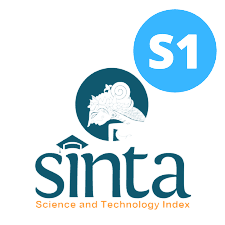Capacitance Value Analysis of Composites of Activated Cashew Shells Charcoal and Iron Sand
Abstract
This study aims to determine the use of iron sand extract and cashew nut shell activated charcoal in the capacitor manufacturing process and determine the effect of grain size on the capacitor capacitance with electrodes from a composite of iron sand extraction and activated charcoal from cashew nutshells. The sample preparation of cashew nutshell activated charcoal was carried out by carbonation and activation methods at a temperature of 700 0C and continued by extracting iron sand. The results of the iron sand extract were then crushed using a mortar, followed by varying the mass fraction of iron sand starting at 40%, 60%, and 80% for each particle size (60 mesh, 100 mesh, and 200 mesh). Then composite the iron sand extract and activated charcoal mixed for 4 hours, and added 0.7 mL of LiNO3 1M solution. The analysis showed that the highest specific capacitance was found in the 200 mesh grain size, namely 0.0695 F/g.
Keywords
Full Text:
PDFReferences
1 Chen, H., Cong, T. N., Yang, W., Tan, C., Li, Y., & Ding, Y. 2009. Progress in electrical energy storage system: A critical review. Prog. Nat. Sci., 19 (3), 291–312.
2 Kim, B. K., Sy, S., Yu, A. and Zhang, J. 2015. Electrochemical Supercapacitors for Energy Storage and Conversion. Handb. Clean Energy Syst., 1 (1), 1–25.
3 Gallay, R.(2005). Properties and State Of The Art of High Power Ultracapacitors, Maxwell Technologies. Rte De Montena, Rossens (Switzerland), Ch-1728.
4 Gautham Prasad, G., Shetty, N., Thakur, S., Rakshitha, and Bommegowda, K. B. 2019. Supercapacitor technology and its applications: A review. IOP Conf. Ser. Mater. Sci. Eng., 561 (1), 1–12.
5 Zhang, S., Lum, C. and Pan, N. 2017. Enhanced performance of carbon/carbon supercapacitors upon graphene addition. Nanotechnol. Environ. Eng., 2 (1), 1–8.
6 Aritonang, S., Jupriyanto, and Riyadi Juhana. 2019. Analysis of The Process of Iron Sand Processing Into Sponge Iron in Order to Support The Defense Industry of Steel Raw Materials. J. Pertahanan Bela Negara., 9 (1), 1–15.
7 Haslinda. 2015. Pengaruh Temperatur Pemanasan Terhadap Kandungan Unsur dan Nilai Suseptibilitas Magnetik Pasir Besi Di Desa Laompo Kecamatan Batauga Kabupaten Buton Selatan. Skripsi. Universitas Halu Oleo.
8 Fayanto, S., Toifur, M. and Anas, M. 2018. Adsorbsi Limbah Timbal ( Pb ) dan Merkuri Tambang Emas Di Sungai Tahi Ete Kecamatan Rarowatu Kabupaten Bombana dengan Menggunakan Biomassa Kulit Biji Mete. Prosiding Konferensi Nasional Ke- 7 Asosiasi Program Pascasarjana Perguruan Tinggi Muhammadiyah Aisyiyah (APPPTMA), 1 (1), 195–199.
9 Wijayanti, H. 2009. Karbon Aktif dari Sekam Padi : Pembuatan Dan Kapasitasnya untuk Adsorpsi Larutan Asam Asetat. Info-Teknik,10 (1), 61–67.
10 Ali. 2015. Arang Aktif Kulit Jambu Mete dengan menggunakan Aktivator HCl, H2SO4, dan NaOH. Skripsi. Universitas Negeri Gorontalo.
11 Aslan, L. K. 2015. Superkapasitor Berbasis Komposit TiO2-Arang Aktif dari Kulit Biji Mete: Efek Ukuran Butir. Skripsi. Universitas Halu Oleo.
12 Cai, N., Cheng, H., Jin, H., Liu, H. and Zhang, P. 2020. Porous carbon derived from cashew nut husk biomass waste for high-performance supercapacitors Ning. J. Electroanal. Chem., 861, 113933.
13 Ye-Xiang, L., Jing, L., Yan-qing, L., Hai-Sheng, S. and Zhang Zhi-an. 2010. Preparation and properties of pitch carbon based supercapacitor. J. Cent. South Univ. Technol., 14 (5), 601–607.
14 Aldila, H., Indriawati, A., Megiyo, Afriani, F., Fauziah, N. and Nuryadin, A. 2019. Synthesis of Carbon Dielectric Composite from Candlenut Shell (Aleurites moluccana). IOP Conf. Ser. Earth Environ. Sci., 353 (1), 1–6.
15 Ahmad, A., Undu, M. A. A., Ahmanas, S. R., Erniwati, and Fayanto, S. 2019. Utilization of iron sand and activated carbon of cashew nut shell as a material basic of lithium battery. AIP Conference Proceedings, 2169.
16 Kurniawan, W. B., Indriawati, A. and Marina, D. 2019. The Effect of Particle Size on the Performance of Electrode Supercapacitor based on Pepper (Pipper Nigrum) Shell Activated Carbon. IOP Conf. Ser. Earth Environ. Sci., 353 (1), 1–6.
17 Rahmah, A., Zainollah, A., Fitriani, N. A., Ramadhan, D. S., Cahayo, M. and Masruroh, M. 2017. EDLC Type Supercapacitor Electrode Based on Banana Peels Activated Carbon. Indones. J. Appl. Phys., 7 (1), 45.
18 Itoi, H., Nishihara, H., Ishii, T., Nueangnoraj, K., Berenguer-Betrián, R. and Kyotani, T. 2014. Large pseudocapacitance in quinone-functionalized zeolite-templated carbon. Bull. Chem. Soc. Jpn., 87 (2), 250–257.
19 Zhang, L. and Zhao, X. S. 2009. Carbon-based materials as supercapacitor electrodes. Chem. Soc. Rev., 38 (9), 2520–2531.
20 Inagaki, M., Kang, F., Toyoda, M. and Konno, H. 2014. Carbon Materials for Electrochemical Capacitors. Adv. Mater. Sci. Eng. Carbon., 2 (1), 237–265.
21 Ruiz-Rosas R., Valero-Romero, M.J., & Salinas-Torres, D. 2014. Electrochemical performance of hierarchical porous carbon materials obtained from the infiltration of lignin into zeolite templates. ChemSusChem., 7 (5), 1458–1467.
22 Pineiro-Prado, I., Salinas-Torres, D., Rosas, R. R., Morallon, E. and Diego, C.-A.. 2016 Design og Activated Carbon/Activated Carbon Asymmetric Capacitors. Front. Mater., 3 (1), 1–16.
23 Ajay, K. M. and Dinesh M. N. 2018. Influence of various Activated Carbon based Electrode Materials in the Performance of Super Capacitor. IOP Conf. Ser. Mater. Sci. Eng., 310 (1), 1–9.
Refbacks
- There are currently no refbacks.
















